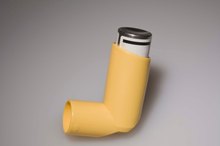Treatment for Asthmatic Bronchitis
Asthma is a condition caused by an overactive immune system. In persons with asthma, the immune system causes inflammation of the airway (the bronchioles), leading to bronchitis. Asthma can be triggered by a number of things, including stress, cold air, exercise and allergies. Although asthma cannot be cured, it can be successfully treated.
If you are experiencing serious medical symptoms, seek emergency treatment immediately.
Chronic versus Acute
Asthma is a chronic condition that causes low-levels of bronchitis. Patients with chronic asthmatic bronchitis often have mild shortness of breath. They may also have a persistent cough as a result of increased mucous secretion (a result of the bronchitis). However, the chronic inflammation and bronchitis can evolve into an acute asthma attack if the immune system is exposed to a "trigger" (a substance which causes a powerful immune reaction). Acute asthmatic bronchitis can cause severe coughing and shortness of breath. In general, asthma initially occurs in children as their immune systems are more sensitive.
- Asthma is a chronic condition that causes low-levels of bronchitis.
- However, the chronic inflammation and bronchitis can evolve into an acute asthma attack if the immune system is exposed to a "trigger" (a substance which causes a powerful immune reaction).
Treatment Goals
List of Drugs Prescribed for Breathing Problems
Learn More
As the National Heart, Blood, and Lung Institute explains, treatment of asthma bronchitis has several goals 1. When a patient is experiencing an acute asthma attack, the goal of treatment is to relieve the symptoms of the attack. Otherwise, treatment aims to prevent these acute episodes. Treatment can also work to improve lung function and allow patients to not be limited in what activities they can perform. There is no cure for asthma, but many patients find that their asthma gets better as they get older.
- As the National Heart, Blood, and Lung Institute explains, treatment of asthma bronchitis has several goals 1.
- There is no cure for asthma, but many patients find that their asthma gets better as they get older.
Acute Treatment
In the event of an acute asthma attack, the Mayo Clinic explains that "rescue" medications are indicated 2. These include rapidly acting bronchodilators, which can be inhaled and work within minutes. These medications help relieve the swelling that bronchitis causes. These rapid-acting bronchodilators include medications known as beta-agonists, which mimic nerve signals to tell the muscles around the bronchioles to relax. Commonly used short-acting beta-agonists include albuterol, pirbuterol and levabuterol. Other rescue medications are ipratropium (another inhaled bronchodilator) as well as corticosteroids.
Chronic Treatment
Differences Between Asthma and Bronchitis
Learn More
According to the American Academy of Allergy Asthma and Immunology, long-term control of asthma is typically maintained with inhaled corticosteroids and long-acting bronchodilators 3. Long-acting bronchodilators include formeterol and salmeterol. These drugs can be used in combination with inhaled corticosteroids (such as fluticasone or beclomethasone) to keep the airways open, helping prevent acute flareups and reducing the long-term symptoms of asthma (such as coughing and shortness of breath). Patients can also use the oral medication cromolyn for control of chronic asthma symptoms. Other treatments for chronic asthma include leukotriene modifiers, which reduce inflammation. Examples of leukotriene modifiers include montelukast and zileuton.
- According to the American Academy of Allergy Asthma and Immunology, long-term control of asthma is typically maintained with inhaled corticosteroids and long-acting bronchodilators 3.
- Other treatments for chronic asthma include leukotriene modifiers, which reduce inflammation.
Asthma and Allergies
In some cases, asthmatic bronchitis can be caused by allergies. In these cases, anti-allergy treatments can be effective at preventing acute asthmatic bronchitis. Omalizumab is a medication which reduces the immune system's response to allergies. Other treatments include antihistamines and allergy shots, which gradually desensitize the immune system to allergens.
- In some cases, asthmatic bronchitis can be caused by allergies.
Related Articles
References
- National Heart, Blood, and Lung Institute: Asthma
- Mayo Clinic: Asthma
- National Heart, Lung, and Blood Institute. Bronchitis.
- Kinkade S, Long NA. Acute bronchitis. Am Fam Physician. 2016;94(7):560-565.
- BMJ Best Practice. Acute bronchitis. Updated April 7, 2020.
- Kudo M, Ishigatsubo Y, Aoki I. Pathology of asthma. Front Microbiol. 2013;4:263. doi:10.3389/fmicb.2013.00263
- Asthma and Allergy Foundation of America. Allergens and allergic asthma. Updated September 2015.
- Asthma and Allergy Foundation of America. Medicines can trigger asthma. Updated August 2018.
- Rosenberg SR, Kalhan R. Chronic bronchitis in chronic obstructive pulmonary disease. Magnifying why smoking Cessation still matters most. Ann Am Thorac Soc. 2016;13(7):999–1000. doi:10.1513/AnnalsATS.201605-360ED
- Gentry S, Gentry B. Chronic obstructive pulmonary disease: diagnosis and management. Am Fam Physician. 2017;95(7):433-441.
- Bonnie F, Marianna S, Suzanne L. Patient information series. Pulmonary function tests. Am J Respir Crit Care Med. 2014;189(10):P17-8. doi:10.1164/rccm.18910P17
- Rogliani P, Ora J, Puxeddu E, Cazzola M. Airflow obstruction: is it asthma or is it COPD?. Int J Chron Obstruct Pulmon Dis. 2016;11:3007-3013. doi:10.2147/COPD.S54927
- Albert RH. Diagnosis and treatment of acute bronchitis. Am Fam Physician. 2010;82(11):1345-50.
- Gatheral TL, Rushton A, Evans DJ, et al. Personalised asthma action plans for adults with asthma. Cochrane Database Syst Rev. 2017;4(4):CD011859. Published 2017 Apr 10. doi:10.1002/14651858.CD011859.pub2
- National Heart, Lung, and Blood Institute. Expert Panel Report 3 (EPR3): Guidelines for the Diagnosis and Management of Asthma.
Writer Bio
Adam Cloe has been published in various scientific journals, including the "Journal of Biochemistry." He is currently a pathology resident at the University of Chicago. Cloe holds a Bachelor of Arts in biochemistry from Boston University, a M.D. from the University of Chicago and a Ph.D. in pathology from the University of Chicago.







